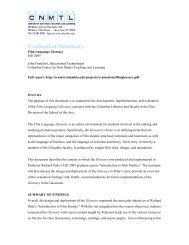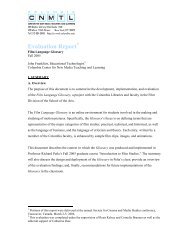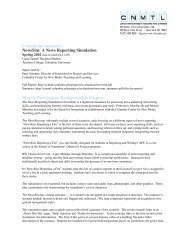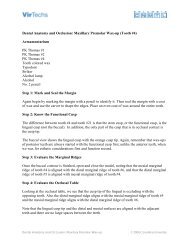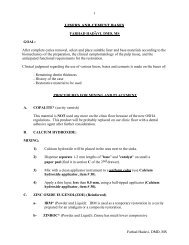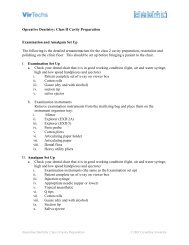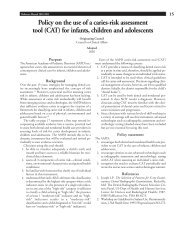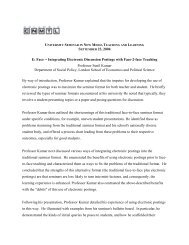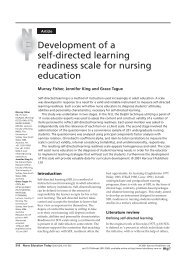Evaluation - Columbia Center for New Media Teaching and ...
Evaluation - Columbia Center for New Media Teaching and ...
Evaluation - Columbia Center for New Media Teaching and ...
Create successful ePaper yourself
Turn your PDF publications into a flip-book with our unique Google optimized e-Paper software.
<strong>Evaluation</strong>:<br />
VITAL (Video Interactions <strong>for</strong> <strong>Teaching</strong> <strong>and</strong> Learning)<br />
Spring 2003 (last revised 09-21-04)<br />
Michael Preston, Educational Technologist<br />
<strong>Columbia</strong> <strong>Center</strong> <strong>for</strong> <strong>New</strong> <strong>Media</strong> <strong>Teaching</strong> <strong>and</strong> Learning<br />
Supervised by:<br />
Peter Sommer, Director of Education <strong>for</strong> Projects <strong>and</strong> Services<br />
<strong>Columbia</strong> <strong>Center</strong> <strong>for</strong> <strong>New</strong> <strong>Media</strong> <strong>Teaching</strong> <strong>and</strong> Learning<br />
<strong>Evaluation</strong>: http://ccnmtl.columbia.edu/projects/evaluations/vital.pdf<br />
Project Description: Background & Purpose<br />
Prof. Ginsburg’s course, “The Development of Mathematical Thinking” at Teachers College, <strong>Columbia</strong> University,<br />
has a unique challenge in that it attempts to make aspects of developmental psychology accessible to a school<br />
teaching population. To make connections between his research-oriented content <strong>and</strong> teaching practice, Prof.<br />
Ginsburg employs an extensive collection of videotapes to illustrate specific phenomena <strong>and</strong> to model techniques<br />
adapted from psychology research that can be used in the classroom. In class, he guides students through videos that<br />
are linked to the weekly topics, using the time to highlight the important concepts, guide students’ viewing of the<br />
videos, <strong>and</strong> encourage discussion <strong>and</strong> debate.<br />
Students have consistently given high ratings to Prof. Ginsburg <strong>and</strong> his course. However, he had long desired<br />
specific improvements to the ways in which he engaged students both inside <strong>and</strong> outside of the classroom.<br />
Responding to these issues was a primary motivation <strong>for</strong> Prof. Ginsburg to work with CCNMTL. Some of these<br />
issues include:<br />
Easier presentation of video clips (eliminate need <strong>for</strong> multiple VHS tapes)<br />
Access to primary source videos outside of class<br />
Once they had access, to provide students with opportunities to use the videos to develop personal, disciplined<br />
theories about children’s abilities <strong>and</strong> the appropriateness of math instruction in the early grades<br />
To address the third issue, the CCNMTL design process attempted to capture the course’s teaching <strong>and</strong> learning<br />
goals in the VITAL environment. These were broken down as follows:<br />
<strong>Teaching</strong> Goals Learning Tasks<br />
Promoting an underst<strong>and</strong>ing of the<br />
mathematics that young children know <strong>and</strong><br />
can do, based on current literature as well as<br />
evidence from video sources<br />
Training teachers in skills adapted from<br />
developmental psychology research that can<br />
provide insight into the contents of children’s<br />
minds<br />
Providing an engaging style of professional<br />
development that empowers teachers to think<br />
critically <strong>and</strong> develop personal theories about<br />
Content: Students will cite <strong>and</strong> provide<br />
examples of the concepts <strong>and</strong> theories of<br />
children’s mathematical thinking at early stages<br />
of cognitive development.<br />
Methodology: Students will per<strong>for</strong>m classroom<br />
observations, clinical interviews with children,<br />
<strong>and</strong> mathematical activities designed <strong>for</strong> the<br />
classroom<br />
Critical thinking: Students will analyze <strong>and</strong><br />
offer their own explanations <strong>for</strong> children’s<br />
behavior, demonstrating critical thinking skills
teaching <strong>and</strong> learning in addition to their underst<strong>and</strong>ing of theory <strong>and</strong><br />
educational methodology<br />
Overview of the <strong>Evaluation</strong> Process<br />
The evaluation examined three types of materials:<br />
Student work, including weekly assignments, video lessons, <strong>and</strong> the final assignment<br />
Commentary on the course, including weekly reflections students in the course <strong>and</strong> Prof. Rochelle Kaplan, guest<br />
observer from William Paterson University in NJ<br />
<strong>Evaluation</strong> materials used throughout the semester, primarily student questionnaires on usability developed by the<br />
DR fellow<br />
Population<br />
There were 39 students enrolled in the course from numerous departments. The main categories were Curriculum &<br />
<strong>Teaching</strong> (Early Childhood Education <strong>and</strong> Special Education), Math/Science/Technology (Mathematics Education),<br />
<strong>and</strong> Human Development (Educational Psychology, Cognitive Studies, <strong>and</strong> Measurement & <strong>Evaluation</strong>). There<br />
were 29 M.A. c<strong>and</strong>idates, 6 Ed.D., 2 Ed.M., <strong>and</strong> two “other.”<br />
Activities<br />
# of Departmental<br />
students Affiliation<br />
14 Mathematics Education<br />
9 Early Childhood Education<br />
6 Cognitive Studies<br />
3 Special Education<br />
2 Developmental Psychology<br />
2 Educational Psychology<br />
2 Instructional Technology<br />
1 Measurement & <strong>Evaluation</strong><br />
Multimedia essays<br />
VITAL enables students to (1) create, annotate, <strong>and</strong> save video clips in a personal workspace, <strong>and</strong> (2) embed their<br />
clips directly into the body of an essay by generating an html link to their video clips. This combination of tools<br />
allows students to cite concrete video evidence in support of their ideas, which in turn allows the instructor to verify<br />
whether students underst<strong>and</strong> the concepts discussed in their essays.<br />
For the course, students were required to use these tools to write multimedia essays in each of the first nine weeks.<br />
The <strong>for</strong>mat <strong>for</strong> all of the essays, excluding the ninth, was the same: (1) to connect the video content with the<br />
readings, (2) to identify any implications <strong>for</strong> classroom practice, <strong>and</strong> (3) to ask any questions that could be addressed<br />
in class. The essays were not to exceed 500 words. The course assistants graded the essays be<strong>for</strong>e lecture <strong>and</strong><br />
provided a summary of key points <strong>and</strong> questions to Prof. Ginsburg so he could address them in his lecture.<br />
In week 9, the essay <strong>for</strong>mat was altered to make the question more specifically tailored to the topic, which happened<br />
to be Pedagogy. Students were asked to watch a series of video segments from a preschool classroom <strong>and</strong> to<br />
identify <strong>and</strong> explain three examples of good teaching. This strategy produced a better quality response: essays were<br />
more coherent, <strong>and</strong> students better integrated their video clips into their essay content.<br />
The final assignment <strong>for</strong> the course was an extended multimedia essay (3500-4000 words) that required students to<br />
describe a learning activity of their own design <strong>and</strong> to reflect upon it critically with citations from their own video<br />
<strong>and</strong> the readings. The project integrated the full breadth of the course content as well as important VITAL<br />
functionality. Students had to complete a multi-step process that involved designing <strong>and</strong> implementing a learning<br />
2<br />
2
activity based on theories of children’s mathematical abilities; using observation <strong>and</strong> clinical interviewing skills to<br />
assess the children’s learning; documenting the experience with digital video; <strong>and</strong> reflecting upon the results in a<br />
multimedia essay. The final assignment also necessitated a certain level of technological proficiency, since many<br />
students had to edit their videos (using iMovie) into a 10-minute segment that could be uploaded to the VITAL<br />
library.<br />
Video lessons<br />
VITAL contains several short “video lessons,” which are series of questions linked to specific video clips. Students<br />
are guided through each lesson <strong>and</strong> asked to submit a response to each question be<strong>for</strong>e moving on to the next. At<br />
any point in the lesson, they can click on a link to view all of their submitted responses on a single page, along with<br />
the associated video clips.<br />
The video lessons were designed to train students in two techniques associated with developmental psychology<br />
research: (1) naturalistic observation, which is the practice of watching children engage in various activities <strong>and</strong><br />
identifying behaviors that reveal specific kinds of thinking (mathematical <strong>and</strong> otherwise), <strong>and</strong> (2) clinical<br />
interviewing, which is a style of interviewing that aims to discover the assumptions <strong>and</strong> thought processes of<br />
subjects.<br />
The video lessons use a scaffolded approach, requiring students to view a video clip or clips, write their reflections<br />
in a text space, receive expert commentary on the clip, <strong>and</strong> then return to the original clip <strong>and</strong> reflect once again. As<br />
the video lessons progress, the amount of expert commentary provided decreases, <strong>and</strong> students are asked to provide<br />
their own observations of the children <strong>and</strong> researchers in the videos <strong>and</strong> to back up their opinions with evidence.<br />
Findings<br />
A. Flexible access to course materials improved student learning<br />
Appropriately enough, Prof. Ginsburg’s fundamental motivation <strong>for</strong> creating VITAL—providing students with<br />
access to the videos outside of class—turned out to be one of the most popular <strong>and</strong> instructionally meaningful<br />
features. Students were universally positive about having the ability to watch the videos wherever <strong>and</strong> whenever<br />
they chose. A large number of them had access to broadb<strong>and</strong> connections at home or at work, so fewer students<br />
than expected used the labs at TC.<br />
Students found the videos to be critical <strong>for</strong> underst<strong>and</strong>ing the course content <strong>and</strong> relating them to their own practice.<br />
Regarding the video content, one student wrote: “The videos helped to bring the readings to life.” In response to the<br />
question “How helpful were the videos in the digital library in terms of allowing you to underst<strong>and</strong> the topic of the<br />
class each week?” the majority of students responded “very helpful.” (On a 1-5 scale where 1 was “very helpful”<br />
<strong>and</strong> 5 was “not helpful,” M=1.33, S=0.53.)<br />
Students were also better prepared <strong>for</strong> lecture each week. When Prof. Ginsburg reviewed the videos during lecture,<br />
students were ready to discuss them in detail because they were already quite familiar with the content. They also<br />
had more time to <strong>for</strong>mulate their own interpretations be<strong>for</strong>e class, which can be attributed to a number of possible<br />
variables: (1) flexible access to the videos <strong>and</strong> (2) tools <strong>for</strong> annotating video clips <strong>and</strong> writing essays, which<br />
prompted a certain level of analysis. Students also engaged in debate over interpretation with Prof. Ginsburg <strong>and</strong><br />
their peers.<br />
Additional student commentary about the videos:<br />
“I especially like the videos that relate to concepts or specifics I read in the readings.”<br />
“Because I compared articles <strong>and</strong> video clips I had many chances to learn.”<br />
“Integrating readings <strong>and</strong> videos was very helpful <strong>for</strong> me to underst<strong>and</strong> the material.”<br />
“I learned a lot of technical conceptual vocabulary concerning mathematical concepts.”<br />
B. Creating video clips helped students learn observation skills <strong>and</strong> course content, but embedding <strong>and</strong> citing the<br />
3<br />
3
clips in their essays was viewed as overly burdensome.<br />
Students learned very quickly how to excerpt video clips <strong>and</strong> write essays. They rated the process to be “helpful”<br />
<strong>for</strong> underst<strong>and</strong>ing the course content. (M=2.05, S=1) The writing of essays was “helpful” to “somewhat helpful”<br />
<strong>for</strong> preparing to attend lecture each week. (M=2.33, S=0.98)<br />
However, students found the workspace limiting <strong>for</strong> writing essays due to the small text area <strong>and</strong> lack of spellchecking<br />
<strong>and</strong> word-counting tools available in most word processors. As a result, most students wrote their essays<br />
in a program outside of VITAL <strong>and</strong> then pasted their text into the workspace. The disadvantages of this method<br />
were (1) having to leave VITAL temporarily in order to complete assignments, <strong>and</strong> (2) having to re-paste inserted<br />
video links from the end of the essay, since VITAL automatically places video links at the end of the text in the box,<br />
rather than wherever the user places his/her cursor.<br />
This writing process ended up being prescriptive, since using an external editor was clearly the superior method in<br />
spite of its technical drawbacks. More significantly, the separation of essay-writing <strong>and</strong> video embedding made the<br />
citation of video an afterthought—a task to be completed in order to satisfy the instructor’s requirements rather than<br />
as a valuable tool <strong>for</strong> supporting theories. The essays were intended to be constructed around the video content, but,<br />
in the end, video content was added later, through a relatively tedious process that was divorced from the creation of<br />
the essays.<br />
Nevertheless, because it was required, nearly all of the students embedded videos in their essays, <strong>and</strong> many students<br />
integrated the video content facilely, with explanatory text that demonstrated an underst<strong>and</strong>ing of the video clips’<br />
meaning. Some students eventually ab<strong>and</strong>oned the video embedding process in favor of text-only citations of video,<br />
explaining that embedding clips was too cumbersome <strong>and</strong> involved too many steps: clipping a video on one place,<br />
accessing it in another, inserting the link into the essay, <strong>and</strong> then moving the link to the appropriate place.<br />
A significant number of students (14 of 39) felt that writing the essays was helpful. Students also appreciated the<br />
ability to view, excerpt, <strong>and</strong> annotate the videos in the library. However, they said that embedding the video clips in<br />
their essays contributed less to their learning, <strong>and</strong> may have even distracted from it. Some students had difficulty<br />
adapting to what they considered a new style of writing, <strong>and</strong>, <strong>for</strong> others, technical difficulties interfered with their<br />
learning:<br />
“[Making video clips] was helpful in that it clarified examples from the readings. It also made the<br />
concepts very concrete. However, all the steps to embed them in the article were time-consuming<br />
<strong>and</strong> added nothing to my learning.”<br />
“I found viewing the videos <strong>and</strong> taking notes to be very helpful. The process of linking the reading<br />
in the essays also helped me to arrange my thoughts. I found that saving video clips <strong>and</strong> then<br />
trying to get them in the right place in my essays to be very distracting. Every time it paused to<br />
save it took a long time <strong>for</strong> the video to restart, <strong>and</strong> I felt that placing them in the essays did not<br />
help much to my underst<strong>and</strong>ing”<br />
“It is a new writing process <strong>for</strong> me to include video references. There<strong>for</strong>e, I am not completely<br />
com<strong>for</strong>table with this additional layer to my writing.”<br />
The essays were graded to reflect the integration of content, specifically, how well the students constructed their<br />
underst<strong>and</strong>ing of the weekly topic around the videos <strong>and</strong> readings. A few well-placed video citations—even one or<br />
two—were generally adequate if the essay was thoughtfully written. The more adept students integrated their video<br />
content as they would use text citations, with their own text framing the citation in order to demonstrate<br />
underst<strong>and</strong>ing <strong>and</strong> relevance. On the more advanced end of the spectrum, students would integrate their video<br />
citations directly into the body of their essays, carefully explain the video content, <strong>and</strong> provide analysis. On the<br />
other end of the spectrum, students would make video citations but not follow up with adequate explanation or<br />
analysis, leaving the reader to guess at the connection being made. However, explicit instructions about using<br />
citations in essays were not provided to students, so there was not a uni<strong>for</strong>m expectation of what students would<br />
4<br />
4
produce. *<br />
C. Assignments <strong>and</strong> reflections created an ongoing dialogue between students <strong>and</strong> instructor<br />
An unanticipated, positive outcome of the intervention was the development of an asynchronous dialogue between<br />
Prof. Ginsburg <strong>and</strong> the students. This dialogue was conducted both online <strong>and</strong> offline <strong>and</strong> followed a sequence that<br />
was repeated in each week of the course:<br />
Students complete an assignment<br />
Prof. Ginsburg gives a lecture that incorporates his feedback on the assignments<br />
Students reflect on what they have learned during the week<br />
The result was highly motivational <strong>for</strong> the students, who knew that their work <strong>and</strong> feedback would be read <strong>and</strong><br />
possibly addressed during lecture. Prof. Ginsburg also benefited, as he had a better sense of what students<br />
understood (<strong>and</strong> did not underst<strong>and</strong>), as well as their unique concerns as representatives of different fields. He was<br />
able to respond more immediately to specific concerns <strong>and</strong> to revise his own course in response to how different<br />
readings, videos, <strong>and</strong> lectures were received.<br />
D. Video lessons were more suited to clinical interviewing than observation<br />
The video lessons were designed to teach observation <strong>and</strong> interview techniques adapted from psychology research.<br />
There are a number of challenges inherent in this goal: (1) to select appropriate videos <strong>and</strong> write questions that focus<br />
attention on the technique being studied, (2) to achieve the intended learning outcome of underst<strong>and</strong>ing the<br />
technique, <strong>and</strong> (3) to make the technique relevant <strong>for</strong> classroom practice, not just the research lab.<br />
The observation lessons tended not to work in the latter sense. The task chosen <strong>for</strong> the lesson was coding a sample<br />
video of two children playing with blocks, first coming up with the codes <strong>and</strong> then using them to describe the<br />
observed behaviors in the video. While this task did focus students’ attention at a granular level, only a few students<br />
saw its relevance to their practice or felt that their per<strong>for</strong>mance improved with repeated watching. In truth, students<br />
had already been learning to observe <strong>for</strong> several weeks by watching the videos in the library <strong>and</strong> clipping them <strong>for</strong><br />
their essays. The clipping <strong>and</strong> annotation tool is probably better <strong>for</strong> teaching students to observe, <strong>and</strong> additional<br />
video lesson work may seem redundant or overly technical.<br />
Examples of student commentary on the observation lessons:<br />
“I learned how to code or possibly code <strong>and</strong> identify mathematical concepts during in<strong>for</strong>mal<br />
games.”<br />
“I learned a lot about data coding <strong>and</strong> observing children from a new perspective.”<br />
“I enjoy the process of learning more each time I watch the clip again.”<br />
“It was a little bit too much; I didn’t feel I have the background in math knowledge to get the most<br />
out of it.”<br />
The clinical interview lessons were more successful than the observation lessons, but the instructors felt that their<br />
structure <strong>and</strong> content could be improved (the first level of challenge described above) to make each lesson’s intent<br />
more clear to the student. After the course, the interview lessons were re-written to focus more explicitly first on the<br />
* More detailed evaluation materials, which examine the work of a sample of students from the course across four<br />
assignments, are available that provide <strong>for</strong> a more thorough analysis of the multimedia essays. This analysis reveals<br />
that students employed a variety of styles <strong>and</strong> levels of analysis in their essays, <strong>and</strong> provides some hypotheses <strong>for</strong><br />
the breadth of results. There is also a discussion of the use of the video clipping tool, which decreased as students<br />
progressed in the course, probably <strong>for</strong> the reasons discussed above. (Please contact CCNMTL, if you wish access to<br />
these materials.)<br />
5<br />
5
subject (the child), <strong>and</strong> second on the interviewer. A third video lesson was created to guide the student through the<br />
following sequence of actions:<br />
Observe behavior <strong>and</strong> <strong>for</strong>m a hypothesis<br />
Establish an alternative hypothesis<br />
State evidence to support your hypotheses<br />
Explain how you would retest<br />
Prof. Ginsburg felt that this model accurately separated out the steps involved in conducting an interview, <strong>and</strong> that<br />
by underst<strong>and</strong>ing each step in isolation, students would gradually internalize the process <strong>and</strong> improve their own<br />
interviewing technique. The impact of this strategy will be tested in future implementations of VITAL.<br />
Recommendations<br />
A. As new videos are developed, it may be valuable to make more explicit connections between the visual <strong>and</strong><br />
written content, to allow students to watch the specific experiments <strong>and</strong> tasks described in the readings. Prof.<br />
Rochelle Kaplan (William Paterson University) also made the following observation about the video content:<br />
“I’d like to work on building a detailed developmental sequence of observations <strong>and</strong> experiences<br />
that would help teacher-students get a clear idea of how symbol systems <strong>for</strong> mathematics develop<br />
from the preschool period through early school learning. I think the in<strong>for</strong>mal symbol systems that<br />
children use need to be highlighted <strong>and</strong> understood as the basis <strong>for</strong> making sense of <strong>for</strong>mal<br />
symbols in kindergarten through second or third grade. Again, we would need additional<br />
videotapes <strong>for</strong> this, particularly on the in<strong>for</strong>mal constructions that children use.”<br />
We might also exp<strong>and</strong> the digital library as per the original specification, in which the library also included text<br />
assets such as journal articles, definitions of key terms used in the course, <strong>and</strong> samples of mathematics curricula.<br />
B. The many steps involved in making clips <strong>and</strong> writing essays should be consolidated into a simple, linear process<br />
that does not overly tax the student while they are concentrating on the course content. For example, video clips<br />
created in the digital library should be made accessible without having to leave the library <strong>and</strong> find them in the<br />
workspace. The workspace should be simplified, <strong>and</strong> the free text area <strong>for</strong> essay writing should be larger <strong>and</strong><br />
incorporate some basic word-processing features, to allow students to <strong>for</strong>mat their work <strong>and</strong> perhaps per<strong>for</strong>m other<br />
tasks, such as spell check. Video links should be inserted into the essay wherever the user designates, rather than<br />
only at the end. Finally, students should be trained in the functionality of VITAL as well as given guidelines <strong>for</strong><br />
essay writing <strong>and</strong> video citation, so that the instructor’s expectations are more transparent.<br />
C. In the second version of VITAL, student reflections were added to the syllabus as a required essay to be<br />
submitted via the workspace. In a future version of VITAL, it would be interesting to try to capture this dialogue<br />
entirely online, in addition to Prof. Ginsburg’s response to assignments in lecture. Some <strong>for</strong>m of threaded<br />
discussion local to particular topics or assignments would allow students to continue the dialogue after lecture <strong>and</strong><br />
allow <strong>for</strong> greater interaction among peers.<br />
D. The video lessons have already been redesigned according to feedback from the first implementation. Lessons<br />
specific to observation should probably be discontinued as lessons, <strong>and</strong> a new assignment <strong>for</strong>mat closer to the<br />
multimedia essay should be created. This <strong>for</strong>mat might incorporate aspects of the Deconstructor tool, which enables<br />
users to capture frames or short clips of video <strong>and</strong> code them. <strong>New</strong>ly developed lessons in clinical interviewing<br />
should be evaluated in future implementations of VITAL in order to test whether the design goals are met on each<br />
level.<br />
E. A research framework <strong>for</strong> VITAL was developed <strong>for</strong> the proposal to the National Science Foundation, <strong>and</strong> the<br />
redesigned VITAL will be evaluated according to that framework. Generally speaking, future studies of VITAL<br />
would benefit from using control groups <strong>and</strong> pre- <strong>and</strong> post-testing in order to measure the impact of the intervention.<br />
6<br />
6
Other experimental manipulations corresponding to specific learning goals should be developed in order to prove or<br />
disprove specific hypotheses about learning in the context of each task. Specific research questions should be<br />
developed well in advance of the course so that researcher roles can be well defined <strong>and</strong> materials prepared well<br />
be<strong>for</strong>e they are needed.<br />
Possible paths <strong>for</strong> future research:<br />
• Compare per<strong>for</strong>mance on a video analysis task between VITAL <strong>and</strong> non-VITAL groups:<br />
Digital library <strong>and</strong> no digital library<br />
Workspace <strong>and</strong> no workspace<br />
Video lesson <strong>and</strong> no video lesson<br />
• Compare content mastery (underst<strong>and</strong>ing the key concepts) between VITAL <strong>and</strong> non-VITAL groups<br />
• Test <strong>for</strong> a relationship between students’ academic background <strong>and</strong> their per<strong>for</strong>mance on specific tasks in<br />
the course<br />
• Test <strong>for</strong> a relationship between essay <strong>and</strong> video lesson per<strong>for</strong>mance <strong>and</strong> final project per<strong>for</strong>mance<br />
• Test <strong>for</strong> a relationship between students’ analysis of materials <strong>and</strong> their use of evidence, video clipping,<br />
different students, different assignments; specifically, which variable is the best predictor of critical<br />
thinking?<br />
7<br />
7




